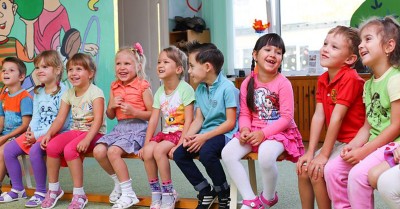Show and Tell gives children an opportunity to stand up in front of their friends and speak about a topic that interest them or share something that they love. It builds confidence and helps children develop effective communication skills.
The Benefits of Show and Tell
- Learning How To Ask Questions: Preschool children do not understand the difference between a statement and a question, and so going through the process helps teach this concept.
- Speech Development: Show and tell provides an opportunity to use descriptive language, concept thinking, story telling and so forth. Overall, it helps develop effective communication.
- Emotional Development: Giving children time to share a part of their home life, their interests, with the group creates an environment of caring and fosters their sense of self and wellbeing.
- Respectful Listening: Show and tell can create structure for preschool children to learn how to be respectful when someone is talking and to use proper manners
- Children Take the Lead: The act of show and tell, from choosing the item, to talking about it in front of peers, to showing it to everyone, provides children the chance to be in charge, and have their choices and voice honoured.
Preparing for Show and Tell
- Once you have decided to include show and tell as part of your program, you will need to inform parents beforehand. Sending out a note to parents will enable you to explain how the show and tell will be run, what to bring, amount of items, size of items, importance of letting the child make a choice etc. Clearly stating the structure and guidelines will make show and tell run more efficiently. Stating the importance of the process of show and tell versus the product is also a good idea to include in the note.
- Decide beforehand how many children will have show and tell in a day, making sure that all children are given a chance during the week or fortnight (depending on the size of the group, days children attend etc). It's a good idea to create a timetable so you and families know which child has show and tell on which day. This can be displayed for parents as well.
- Clearly provide children who are having show and tell the following day, a visual cue to send home. For example for a visual reminder, clip notes onto onto backpacks that are labelled with large lettering, “its My Show and Tell Turn” or have a selected Show and Tell Mascot with the same label clipped onto the child’s backpack. You could also remind parents during pick ups, through email, parent pockets, communication books etc.
- Plan show and tell around a theme or if a special events has happened in a child's life such as a birth of a sibling or returning from a holiday.
- Include ideas for the parents, send some ideas that the children could bring in for show and tell, if you're planning a theme.
Extending Children's Learning Through Show and Tell
At this age, Show and Tell should reflect their growing abilities to speak, ask questions, and understand others. The following strategies can help preschoolers learn through Show and Tell:
- Extend Show and Tell by creating themes that interest the children, such as a favourite board game, favourite movie, favourite animal, and favourite stuffed animal.
- Encourage children to ask each other questions and only intervene when needed.
- Plan a time for Show and Tell when children are most likely to be able listen to each other, such as after playing outside or at the beginning of the day.
- Repeat rules such as “One person speaks at a time” before Show and Tell begins and remind the children when necessary throughout the activity.
- Find ways to expand Show and Tell, such as breaking the children into groups to do Show and Tell, asking children to demonstrate a skill, or creating artwork and/or poster boards about a topic of interest.
Hints and Tips for Running Show and Tell
Show and tell will bring out the different personalities of each child. Following the same steps with each child consistently will quickly illustrate to the children what to expect and the guidelines for show and tell.
- Child stands in front of the group who are sitting in a circle.
- Child shows the item and talks about it, Educator guides only if needed.
- Child can show the item to each child, if he/she wishes by walking around the circle.
- Child chooses two people for questions, then answers.
- Everyone claps and the teacher says thank you for sharing.
- Model how to ask questions, and how to listen to the group at the very beginning of show and tell.
- Puppets can also be used to demonstrate. Teaching children beforehand what questions are will also aid in the smooth process of show and tell.
- Keep each child’s turn short.
- Choose the same three questions to ask each child so that the questions are predictable.
- Coach children on how to ask questions.
- Allow children to choose items to bring that are meaningful to them.
- Set rules on the types of items you don’t want children to bring it ahead of time and inform parents at the start of show and tell.
- Children who might forget to bring an items can choose a favourite book, toy, art activity, or other item from the room so no one gets left out.
Children benefit from experiences that are well-planned, built on interests, and developmentally appropriate. Show and Tell should not be an exception. The integrity of this experience is accomplished when children learn something, which means the process of Show and Tell must change as children change.
References:
- Show and Tell For Preschoolers, Illnois Early Learning
- Parent Involvement In Show and Tell, Bright Hub Education
- Show and Tell Day In Preschool, Teach Preschool



 As an Educator in Australia, your pay rate falls under the Children’s Services Award 2010. This award states the minimum amount that an employer can
As an Educator in Australia, your pay rate falls under the Children’s Services Award 2010. This award states the minimum amount that an employer can When working as a qualified Early Childhood Teacher (with a university degree) within a service, your rate of pay will come from the Educational Services
When working as a qualified Early Childhood Teacher (with a university degree) within a service, your rate of pay will come from the Educational Services When working as a Diploma Qualified Educator your pay rate is from the Children's Services Award 2010. This Award states your minimum rate of pay
When working as a Diploma Qualified Educator your pay rate is from the Children's Services Award 2010. This Award states your minimum rate of pay When working as a Cert 3 Qualified Educator, your pay rate is from the Children's Services Award 2010. This Award states your minimum rate of
When working as a Cert 3 Qualified Educator, your pay rate is from the Children's Services Award 2010. This Award states your minimum rate of Educational Leaders play a crucial role in their early childhood service by ensuring that the educational program aligns with best practices and supports the holistic
Educational Leaders play a crucial role in their early childhood service by ensuring that the educational program aligns with best practices and supports the holistic In early childhood education and care, ratios are more than a technicality—they are a frontline safeguard. Every child deserves responsive supervision, emotional connection, and developmental
In early childhood education and care, ratios are more than a technicality—they are a frontline safeguard. Every child deserves responsive supervision, emotional connection, and developmental With the new national child safety reforms kicking in on 1 September 2025, early childhood services like yours have a real opportunity to lead the
With the new national child safety reforms kicking in on 1 September 2025, early childhood services like yours have a real opportunity to lead the Here’s a comprehensive Mobile Phone and Smart Watch Policy tailored for early childhood education and care (ECEC) services in Australia, aligned with the latest 2025
Here’s a comprehensive Mobile Phone and Smart Watch Policy tailored for early childhood education and care (ECEC) services in Australia, aligned with the latest 2025 The Sea of Fish Challenge is a national initiative that invites children, educators, families, and communities to create and display fish artworks as a symbol
The Sea of Fish Challenge is a national initiative that invites children, educators, families, and communities to create and display fish artworks as a symbol Across the early childhood education and care sector, educators are sounding the alarm: current staffing ratios are insufficient to deliver safe, meaningful, and developmentally appropriate
Across the early childhood education and care sector, educators are sounding the alarm: current staffing ratios are insufficient to deliver safe, meaningful, and developmentally appropriate


